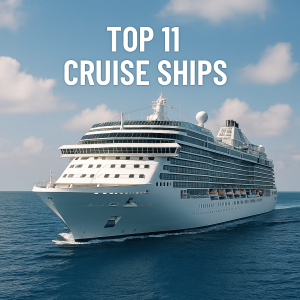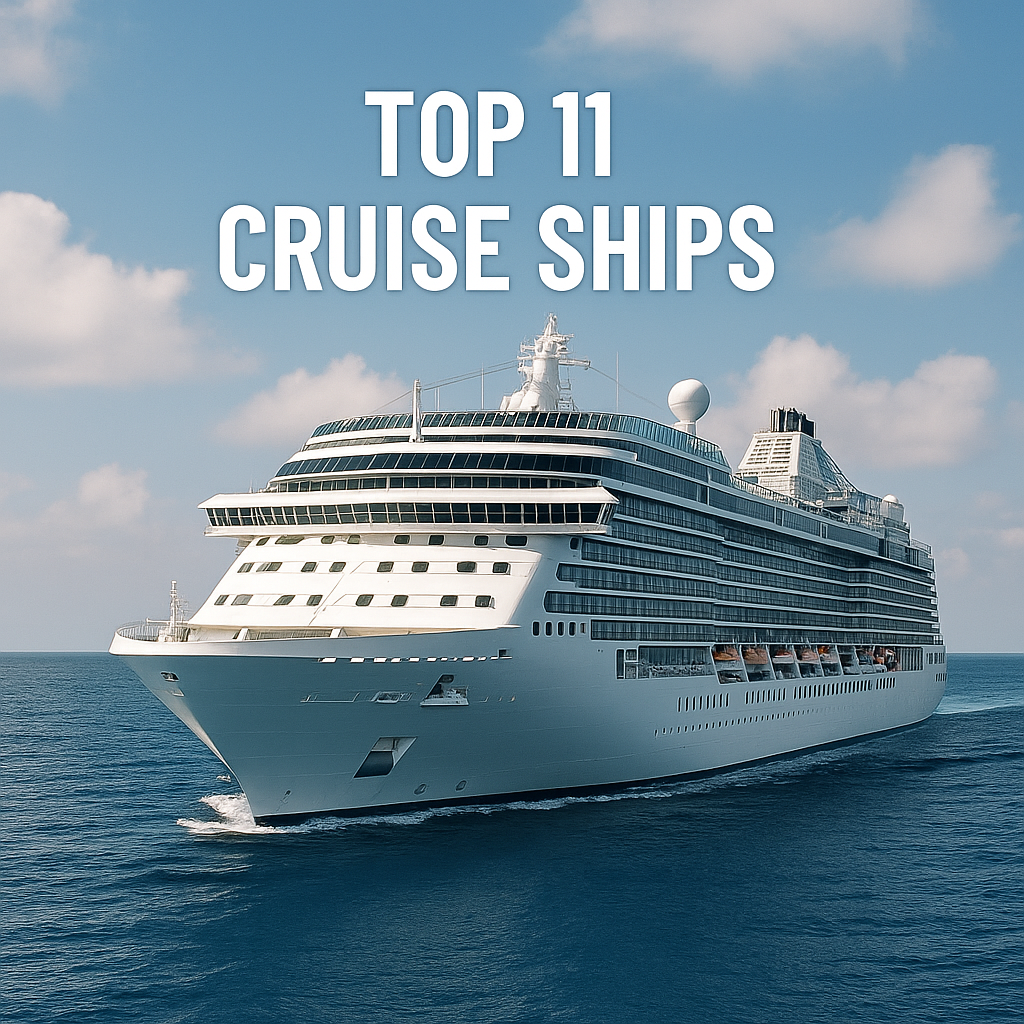Discover the top 11 cruise ships reshaping global maritime tourism. Learn about their size, technology, real-world stories, and future trends in this captivating educational guide.
More Than Just Floating Hotels
Standing on a cruise ship deck, gazing at the endless blue, you might feel like you’re on a floating city. Modern cruise ships are far more than hotels at sea; they are marvels of naval architecture, engineering, hospitality, and environmental innovation. As passenger demands grow, so too do the ships — bigger, greener, smarter, and bolder than ever.
Today’s top cruise ships are not only massive but also highly advanced, blending green technology, luxury, and maritime safety systems to carry tens of thousands of guests across the world. These giants represent the cutting edge of passenger shipping, offering insights into maritime engineering and sustainable practices.
In this in-depth educational guide, we’ll explore the top 11 cruise ships making waves today, and why they matter for the future of the maritime industry.
Why These Cruise Ships Matter in Modern Maritime Operations
Cruise ships are among the most complex vessels afloat. They combine elements of commercial shipping, hotel management, tourism, environmental compliance, and even small-scale city planning.
For the maritime sector, these ships:
✅ Drive innovation in green ship design and alternative fuels.
✅ Provide vital training opportunities for thousands of seafarers.
✅ Stimulate port infrastructure development worldwide.
✅ Represent major investments in classification, certification, and port-state control compliance.
✅ Strengthen public appreciation for maritime culture and seafaring heritage.
According to the Cruise Lines International Association (CLIA, 2023), cruise ships generate billions of dollars in economic activity, supporting over 1.2 million jobs worldwide — many of them maritime.
Key Technologies and Developments Driving Change
The biggest cruise ships increasingly feature these cutting-edge technologies:
- Liquefied Natural Gas (LNG) Propulsion: dramatically reducing sulphur oxides and particulates.
- Advanced wastewater treatment: exceeding IMO MARPOL Annex IV discharge limits.
- Shore power: plugging into port electricity to reduce emissions while docked.
- Dynamic positioning systems: improving maneuvering without anchors, preserving sensitive seabeds.
- Smart energy management: integrating solar panels and battery systems to further cut fuel consumption.
Reports from DNV, ABS, and the Royal Institution of Naval Architects highlight how these ships are at the forefront of marine innovation, driving the entire industry toward IMO’s 2050 decarbonisation targets.

The Top 11 Cruise Ships You Need to Know
Let’s dive into these magnificent giants that define the modern cruise industry.
Wonder of the Seas (Royal Caribbean)
The world’s largest cruise ship by gross tonnage (over 236,000 GT), Wonder of the Seas launched in 2022 and can accommodate nearly 7,000 passengers. Its seven “neighbourhood” concept zones make it feel like a floating theme park, including a massive open-air park with real plants.
Royal Caribbean uses advanced air lubrication systems on Wonder of the Seas, reducing hull resistance to improve fuel efficiency — a remarkable engineering achievement recognised by DNV.
👉 Royal Caribbean – Wonder of the Seas
Symphony of the Seas (Royal Caribbean)
Sister to Wonder of the Seas, Symphony of the Seas entered service in 2018 with a capacity of 6,680 guests. Its environmentally optimised hull shape, waste heat recovery systems, and LNG readiness position it among the greenest giants afloat.
Beyond tech, Symphony offers one of the largest aquatheatres at sea, illustrating how maritime design is merging with high-level entertainment.
Icon of the Seas (Royal Caribbean)
Set to launch in 2024, Icon of the Seas is already stirring excitement. With groundbreaking hybrid LNG/battery systems and a capacity exceeding 7,600 guests, it’s a symbol of where passenger shipping is going — sustainable, spacious, and spectacular.
Royal Caribbean has pledged a 50% reduction in carbon emissions per passenger by 2030, with Icon of the Seas as its flagship example.
MSC World Europa (MSC Cruises)
Delivered in 2022, MSC World Europa represents MSC’s shift toward LNG and advanced green tech. It uses a next-generation hull form for drag reduction, a hybrid power plant, and advanced greywater recycling, blending environmental priorities with luxury.
Carrying over 6,700 passengers, World Europa also helped transform the Port of Marseille, requiring upgrades in shore power connections and LNG bunkering facilities — showing how a ship can drive port innovation.
Norwegian Prima (Norwegian Cruise Line)
Norwegian Prima, delivered in 2022, brings a boutique-style luxury experience to large-scale cruising, accommodating about 3,200 guests. It boasts the first three-level race track at sea, but also features low-emission exhaust systems and selective catalytic reduction to cut NOx emissions.
Prima’s design supports Norwegian Cruise Line’s goals to become carbon-neutral by 2050, in step with IMO climate guidelines.
Iona (P&O Cruises)
As the first British LNG-powered cruise ship, Iona is a major sustainability milestone for P&O Cruises. Launched in 2021, it carries over 5,200 passengers with remarkable energy efficiency thanks to cutting-edge energy recovery systems.
Iona also set new standards for crew training, with a focus on environmental management skills certified by the UK Maritime and Coastguard Agency (MCA).
Mardi Gras (Carnival Cruise Line)
Named after Carnival’s first-ever cruise ship, Mardi Gras is a bold reinvention of cruising with LNG propulsion and an onboard roller coaster. It serves 6,400 passengers and demonstrates Carnival’s commitment to IMO Tier III emissions standards.
Mardi Gras is also the first ship of its kind to use Carnival’s new advanced wastewater purification system, pushing environmental compliance to a higher level.
Celebrity Beyond (Celebrity Cruises)
Launched in 2022, Celebrity Beyond is the third in Celebrity’s Edge series and one of the most technologically advanced ships ever built. Its fuel efficiency benefits from a unique parabolic bow, while an innovative microbubble system reduces drag.
Beyond hosts around 3,260 guests, combining stunning design with environmental consciousness.
Enchanted Princess (Princess Cruises)
Enchanted Princess, delivered in 2021, serves 3,660 guests in luxurious style. Equipped with advanced scrubbers, shore power connectivity, and a smart trim optimisation system, it represents modern sustainable cruising.
Princess Cruises also invested in new crew training simulators for Enchanted Princess, highlighting a wider maritime workforce upskilling trend.
AIDAnova (AIDA Cruises)
As the world’s first cruise ship powered fully by LNG, AIDAnova (2018) is a true pioneer. With capacity for 6,600 guests, its environmentally friendly fuel system dramatically reduces sulfur oxides and particulate emissions.
AIDAnova was so influential that it inspired a new generation of LNG-powered cruise ships, creating ripples in shipyards and ports around Europe.
Spectrum of the Seas (Royal Caribbean)
Launched in 2019, Spectrum of the Seas is a Quantum-Ultra class ship for Asian markets, hosting up to 4,246 guests. It uses an advanced Azipod propulsion system and energy recovery systems, meeting IMO Tier III requirements.
Spectrum’s focus on Asian cruising also demonstrates how cruise ships adapt to diverse cultural and regional markets — a powerful lesson for maritime business students.
👉 Royal Caribbean Spectrum of the Seas
Challenges and Solutions in Mega Cruise Ship Development
Environmental Impact
Cruise ships have faced criticism over carbon emissions, wastewater discharge, and marine wildlife risks. New-generation ships use LNG, shore power, and advanced wastewater systems to address these challenges.
Regulatory Hurdles
Compliance with IMO MARPOL, SOLAS, and regional emission control areas (ECAs) is costly but necessary. Partnerships with classification societies like Lloyd’s Register and DNV ensure these ships meet evolving safety and environmental rules.
Port Capacity
Massive cruise ships demand huge port investments, from terminal expansions to upgraded fueling systems. According to the International Association of Ports and Harbors (IAPH), ports are racing to accommodate ever-larger vessels.
Extreme Weather
As climate change increases storm risks, cruise ships are being built with stronger hulls, advanced stabilization, and robust evacuation systems to protect passengers.
Case Studies and Real-World Applications
PortMiami Modernisation
To accommodate ships like Symphony of the Seas and Icon of the Seas, PortMiami invested over $250 million in new terminals, shore power hookups, and security upgrades — a true transformation of maritime infrastructure.
Mardi Gras LNG Logistics
Carnival’s Mardi Gras required new LNG bunkering arrangements in Port Canaveral, working with Shell and the U.S. Coast Guard to create safe fuel handling protocols.
MSC World Europa’s Marseille Partnership
The Port of Marseille adapted its facilities for LNG refueling, proving how ship–shore cooperation supports decarbonisation.
Future Outlook for the Cruise Ship Industry
According to CLIA (2023) forecasts, cruise passenger demand will exceed 35 million globally by 2030. To serve these guests, cruise ships will:
✅ Become even larger, but more energy-efficient
✅ Integrate hybrid propulsion systems and biofuels
✅ Strengthen partnerships with maritime training academies
✅ Develop “smart ship” features using AI for route optimisation and maintenance
✅ Work closely with regulators to manage marine biodiversity
Cruise shipping is set for a bright — and greener — future.
Frequently Asked Questions
Why are cruise ships getting so big?
Economies of scale reduce passenger costs while adding amenities.
How do cruise ships handle waste?
They use advanced wastewater treatment and solid-waste incineration, following IMO MARPOL guidelines.
Can cruise ships really use LNG safely?
Yes, LNG bunkering protocols are tightly regulated and proven safe under international standards.
Do cruise ships cause marine pollution?
Modern ships dramatically reduce emissions and discharge compared to older fleets.
What is the largest cruise ship in the world?
Wonder of the Seas holds that record as of 2024.
Are cruise ships vulnerable to storms?
They are built with advanced stabilization and evacuation systems to handle severe weather.
Do crew members get environmental training?
Yes, many cruise lines partner with maritime academies and certification bodies to train their crews.
Conclusion: A Sea of Opportunity
These eleven cruise ships are more than floating palaces. They are an evolution of maritime design, sustainability, and passenger experience. For maritime students, professionals, and enthusiasts, they stand as modern marvels — symbols of where seafaring is heading.
As shipping lines continue to push technological, environmental, and social boundaries, these ships will inspire innovation for years to come. Whether you’re an engineer, a port planner, or a passenger, the future of cruising is a journey worth following.
If you’d like, I can help break this down into a training module or interactive slideshow — just let me know! 🌊

